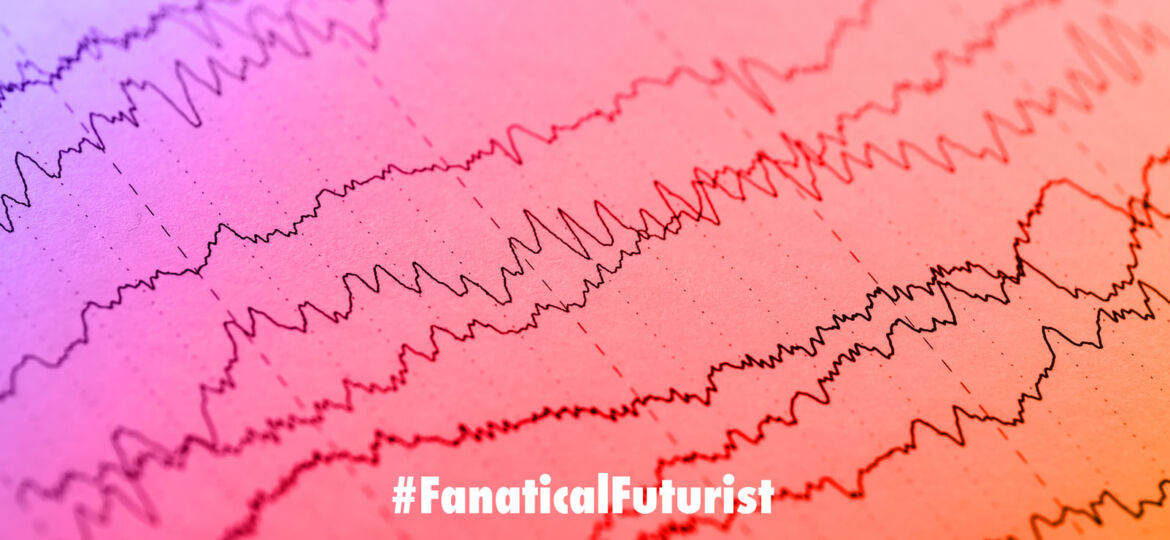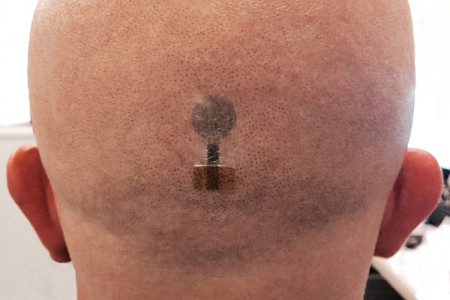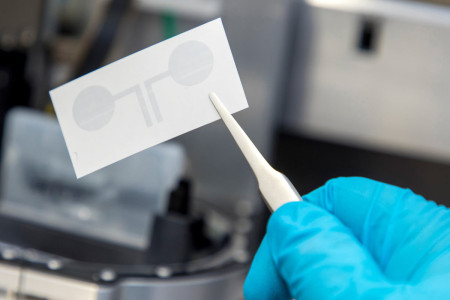
WHY THIS MATTERS IN BRIEF
Controlling technology with our minds will bring about a revolution in computing and computer interfaces, and this new BMI Smart Tattoo brings it into everyone’s reach.
 Interested in the Exponential Future? Connect, download a free E-Book, watch a keynote, or browse my blog.
Interested in the Exponential Future? Connect, download a free E-Book, watch a keynote, or browse my blog.
One of the facts about exponential technologies is that over time they always increase in performance and capability, get cheaper to buy and produce, and, of course, become miniaturised. Take Brain Machine Interfaces (BMI) for example, in the beginning they were bulky and massive, and in order to get the fastest and most accurate readings from people’s brains they needed to be invasive, and many still are like these ones that are helping people with paralysis control swarms of F-35 fighter jets, or this one developed by Elon Musk’s Neuralink outfit that wants to one day “merge people and AI’s” together.
Over time though BMI’s, like the ones embedded into HTC’s VR headset, and the ones used to stream people’s thoughts to TV, have gotten more accurate at reading people’s minds using non-invasive tech, and now those large blue skull caps are about to be reduced to a sticker-like tattoo that’s as small as a coin.
Outside of Soundcloud rappers and professional wrestlers like the late Bam Bam Bigelow, head tattoos aren’t something most of us encounter on a regular basis. But if researchers at Austria’s Graz University of Technology and a couple of other European research labs have their way, that could all be about to change. Head tattoos may become the norm — mind-reading, electrode-sporting head tattoos. Before I get any further though, no, the tattoos aren’t permanent which makes their utility even better.
“We use temporary tattoos like smart tattoos or the ones for kids more and more today,” says Francesco Greco, assistant professor at the university’s Institute of Solid State Physics. “In our new tattoo we use the [standard tattoo] paper as a substrate and then print on top of it circuits made out of conductive polymer, using an inkjet printer.”
The recipient sticks one or more of these adhesive tattoo electrodes onto their scalp. The tattoos can then be used to record high-quality Electroencephalography (EEG) brain signals fresh off the scalp. In contrast to gel electrodes, there is no need for a liquid interface and the tattoos cannot dry out. Even hairs growing through their ultra-thin membrane don’t stop them from effectively performing their job.
While the tattoo electrodes are not exactly invisible, anyone shaved bald and sporting a small circuit board glued to their head has a funny habit of being conspicuous, they don’t interfere with the wearer the way that a conventional EEG electrode headset might do. The fact that they could be applied and then forgotten about is one of their most exciting aspects, making them perfectly suited for longer-term measurements, and they stay on until scrubbed with soap and water to remove them.
Greco’s lab, the Laboratory of Applied Materials for Printed and Soft electronics (LAMPSe), developed the first tattoo electrodes in 2015. The first use case of these adhesive transfers was to measure heart rate and muscle activity. Half a decade on, Greco and others have optimized the technology so that it can be used to measure brain waves every bit as effectively. The work was carried out alongside researchers in both France, at the École des Mines de Saint-Étienne, and in Italy by Laura Ferrari at Scuola Universitaria Superiore Pisa.
“EEG, or electroencephalography, was always the most challenging step,” said Esma Ismailova, bioelectronic textiles group leader in the department of bioelectronics at Ecole Nationale Supérieure des Mines de Saint-Étienne. “We have now reached the ultimate step where we can [gather] brainwaves that are low amplitude and high frequency. It is very [difficult] to catch this kind of activity.”
There are multiple reasons why gathering brain data could be useful. One is for monitoring. The Electrocardiogram (ECG) reader found in the Apple Watch has already compellingly demonstrated why wearables that constantly monitor our vital signs can be useful. In the case of the Apple Watch, conditions like atrial fibrillation, an irregular heart rhythm that can cause strokes, can be spotted by continually monitoring wearers’ heartbeat. If something goes wrong, the smartwatch can alert the user so that they may seek medical help.
At present, there is no such thing as regular brainwave monitoring. Neurological conditions like epilepsy may be diagnosed using EEG technology but it is unlikely patients will have regular, or even irregular, brainwave monitoring afterward.
“In the case of epilepsy, you cannot really predict an episode, you need to be able to monitor the patient,” Ismailova explained. “This kind of electrode could be used to monitor the patient at home to help clinicians to understand the origins [of the illness] and how it is propagated. They can evaluate it over time.”
There are other practical use cases, too. Greco thinks that this non-invasive brainwave monitoring tech might prove a crucial step in helping other researchers around the world develop increasingly more effective non-invasive BMI technologies that one day would be small enough and sensitive enough to be built into everyday smart devices like your smartphone or the ones in your smart connected home.
“One of the wonderful things that could be possible, and that we are trying to study now, is to capture information from the brain [for use in different applications],” he said. “For example, you could capture this information, send it directly through a [BMI], and use it to stimulate the muscles of a paralysed patient. In a paralysed patient, the brain is perfectly functioning, the muscles are perfectly functioning, but the neural communication is lost between these two points. We could try to recover disconnection by way of a [BMI].”
Then there are all the other potential applications of a BMI — such as monitoring mood or desires and pulling up the right information at the right time. It may even be possible to combine a brain-monitoring tattoo electrode with temporary tattoos monitoring muscle activity in other parts of the body as an added source of data.
Does Greco believe that, within our lifetimes, waking up and slapping on a low cost wearable tattoo sensor could be as commonplace as putting on our watch or slipping our smartphone into our pocket?
“Yes, I think so, because there are lots of practical applications in daily life [where this could be useful,]” he said.
At present, this work is still a proof-of-concept demonstration rather than anything ready to be commercialised. The processing of information still needs to be carried out by wiring the electrodes to an external device. However, Greco points out that other research groups are busy working on wearables that could enable this information to be processed on the body. It could potentially also be transmitted wirelessly to a smartphone or smartwatch.
All of this remains speculation for now. But, like so much about modern wearables, these use cases exist in the realm of science fiction only until they suddenly don’t.
A paper describing the research was recently published in the journal NPJ Flexible Electronics.



















[…] and increasingly these thin little pieces of material are being used to create smart tattoos that read people’s minds and to create an entirely new class form of edible electronics that have a myriad of […]
[…] the machines behind helping researchers decode and transmit your thoughts – all of them, moods, sight, sound, even the daydreams, memories, and secrets in your mind – directly to the gadgets […]